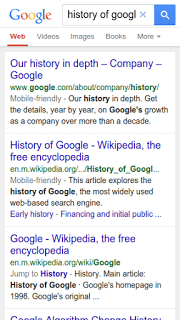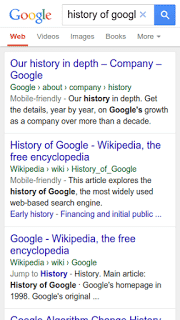Unlike your home address, which says nothing about you or your family, a thoughtful and well-formed webpage address (also known as a URL) typically describes something about the webpage itself. It can describe the subject of the page or perhaps hint at the page’s location within the overall website. To emphasize this purpose, Google updated the algorithms that control the display of URLs in mobile search results on April 16, 2015. Let’s learn a little more about this Google URL update . . .


Note the difference in the way the URL’s are represented in the above example
The Google URL Update
So what’s changed?
According to the Google Webmaster Central Blog, the updated algorithms will “better reflect the names of websites, using the real-world name of the site instead of the domain name, and the URL structure of the sites in a breadcrumbs-like format.” You can see this shift in structure in the before and after photos above. The web address is not displayed at all; it is replaced by a broken-down URL in a breadcrumb arrangement.
Anything else?
Google also announced support for Schema.org structured data. This site name markup allows webmasters to give signals to Google’s algorithm, dictating (1) the website name that they would like to be used in place of the domain name and (2) the URL structure of the URL in breadcrumb form. To refresh your memory, breadcrumbs are links that help your site’s viewers understand your site’s hierarchy and organization. Like the breadcrumb trail left by Hansel and Gretel, this trail of links can help viewers find their way within the forest of your website.
What does this mean for me and my site?
Although your website’s URL structure was significant before last week, now that Google has made these algorithm changes, your URLs and breadcrumbs more important than ever before because they will be more visible in mobile search results. So, take a minute and check out how your site’s name is being displayed in mobile search results. If you don’t like what you see, it’s time to use the new markup. And even if you do like what you see, it’s probably not a bad idea to take control of the URL markup, because you can’t always trust Google to show your website in its best light. Finally, it’s important to realize how prominent your brand name will now be within search results. If you aren’t pleased with your current choice, now might be a good time to change your brand.
Should I be concerned about any negative effects?
Probably not. So far, we haven’t seen a positive or negative change for keyword-rich domain names. However, we are concerned about the potential for spoofing. If someone created a site with a similar name to a more popular site, they might benefit due to the similarity in search result URL displays.
So, if you need to update your site’s URLs or breadcrumbs, now is the time! Although the update currently only affects mobile search results (and the changes will be introduced gradually), it is very likely that Google will implement the change on desktops someday as well.
Do you need help making your website mobile-friendly? You may want to contact 417 Marketing, an online marketing company based in Springfield, Missouri. We specialize in SEO (search engine optimization), PPC (pay-per-click) marketing, and mobile-friendly web design. Click here to contact us.


